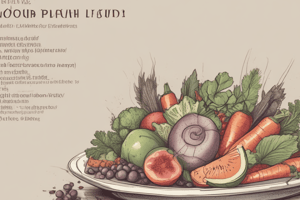Podcast
Questions and Answers
What are the Dietary Reference Intakes?
What are the Dietary Reference Intakes?
The Dietary Reference Intakes (DRI) is a set of values for vitamins, minerals, carbohydrates, fiber, lipids, protein, water, and energy, indicating adequate and safe intakes of essential nutrients.
What is the Acceptable Macronutrient Distribution Range, and what are its specific values?
What is the Acceptable Macronutrient Distribution Range, and what are its specific values?
The Acceptable Macronutrient Distribution Range (AMDR) is a set of healthy intake ranges: 45-65% of calories from carbohydrates, 20-35% from fat, and 10-35% from protein.
Which is the most appropriate use of information on Daily Values?
Which is the most appropriate use of information on Daily Values?
Daily Values are ideal for allowing comparisons among foods, such as comparing calories in different cereals.
Which set of Dietary Reference Intakes would be used for establishing policies and recommendations?
Which set of Dietary Reference Intakes would be used for establishing policies and recommendations?
What is the recommended intake for iron for a 20-year-old female and male?
What is the recommended intake for iron for a 20-year-old female and male?
What is the recommended intake for vitamin A for an 18-year-old female, and how much is too much?
What is the recommended intake for vitamin A for an 18-year-old female, and how much is too much?
How much is too much vitamin C for an adult?
How much is too much vitamin C for an adult?
What is the accurate assessment of Grandma Jenkins' calcium intake?
What is the accurate assessment of Grandma Jenkins' calcium intake?
What is the purpose of the Dietary Guidelines for Americans?
What is the purpose of the Dietary Guidelines for Americans?
Which of the following is part of the legume subgroup of vegetables? (Select one)
Which of the following is part of the legume subgroup of vegetables? (Select one)
Which option would equal 4 oz of grain? (Select one)
Which option would equal 4 oz of grain? (Select one)
According to the Food Patterns, which is equivalent to 1 ounce of meat?
According to the Food Patterns, which is equivalent to 1 ounce of meat?
Flashcards
Dietary Reference Intakes (DRI)
Dietary Reference Intakes (DRI)
A set of nutrient intake recommendations for vitamins, minerals, carbohydrates, fats, protein, water, and energy, developed to ensure adequate and safe intake.
Acceptable Macronutrient Distribution Range (AMDR)
Acceptable Macronutrient Distribution Range (AMDR)
The healthy intake ranges for carbohydrates, fat, and protein, expressed as a percentage of total daily calories.
Estimated Average Requirement (EAR)
Estimated Average Requirement (EAR)
The amount of a nutrient that meets the needs of 50% of healthy individuals in a specific life-stage and gender group.
Recommended Dietary Allowance (RDA)
Recommended Dietary Allowance (RDA)
Signup and view all the flashcards
Tolerable Upper Intake Level (UL)
Tolerable Upper Intake Level (UL)
Signup and view all the flashcards
Legumes
Legumes
Signup and view all the flashcards
Grain Equivalents
Grain Equivalents
Signup and view all the flashcards
Dietary Guidelines for Americans (DGA)
Dietary Guidelines for Americans (DGA)
Signup and view all the flashcards
Daily Values
Daily Values
Signup and view all the flashcards
Meat Equivalents
Meat Equivalents
Signup and view all the flashcards
Calcium UL
Calcium UL
Signup and view all the flashcards
Food Patterns
Food Patterns
Signup and view all the flashcards
Study Notes
Dietary Reference Intakes (DRI)
- DRI encompasses values for vitamins, minerals, carbohydrates, fiber, lipids, protein, water, and energy.
- Developed by nutrition science experts to indicate safe and adequate nutrient intakes.
- Key components include RDA (Recommended Dietary Allowance), AI (Adequate Intake), EAR (Estimated Average Requirement), UL (Tolerable Upper Intake Level), and AMDR (Acceptable Macronutrient Distribution Range).
Acceptable Macronutrient Distribution Range (AMDR)
- AMDR defines healthy intake ranges for carbohydrates, fat, and protein.
- Recommended percentage of total daily calories:
- 45-65% from carbohydrates
- 20-35% from fat
- 10-35% from protein
Daily Values
- Daily Values are useful for comparing nutrient content in different foods, such as cereals.
Estimated Average Requirement (EAR)
- EAR indicates the average daily nutrient intake to meet half of the healthy individuals' needs in a specific group.
- Essential for assessing population nutrient intakes and forming dietary recommendations.
Recommended Dietary Allowance (RDA)
- RDA for iron:
- 20-year-old female: 18 mg/day
- 20-year-old male: 8 mg/day
- RDA for vitamin A for an 18-year-old female: 700µg/day.
- Vitamin A toxicity level (UL) for an 18-year-old female: 2800 µg/day.
Tolerable Upper Intake Level (UL)
- UL for vitamin C: 2000 mg/day for adults, indicating the maximum daily intake unlikely to cause toxicity.
- UL for calcium: 2500 mg/day. Excess intake can be toxic.
Calcium Intake Assessment
- Grandma Jenkins takes 3600 mg of calcium daily from supplements, surpassing the recommended intake of 1200 mg.
- Intake exceeds the UL of 2500 mg, posing a risk of toxicity.
Dietary Guidelines for Americans (DGA)
- The DGA promotes health and reduces chronic disease risk through diet and physical activity.
- Recommends a healthy diet and physical activity while limiting harmful dietary elements.
Legume Classification
- Legumes include dried beans, peas, and lentils.
- Split peas qualify as a legume, while other options like beet greens, green peas, and green beans do not.
- Legumes can be categorized as vegetables or meat alternates based on serving sizes.
Grain Equivalents
- 1 oz of grain: equivalent to a slice of bread, ½ cup of cooked rice, pasta, or cereal, 1 oz of dry pasta/rice, or 1 cup ready-to-eat cereal.
- 2 sandwiches (4 slices of bread) equal 4 oz of grain, the correct choice for Kevin's lunch.
Food Patterns and Meat Equivalents
- 1 ounce of meat equivalent according to Food Patterns is typically evaluated based on serving size and protein content.
Studying That Suits You
Use AI to generate personalized quizzes and flashcards to suit your learning preferences.




